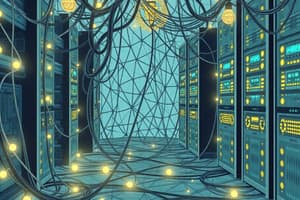Podcast
Questions and Answers
What is a server?
What is a server?
A computer that manages the network resources, software, and files.
What is a workstation?
What is a workstation?
A computer intended for individual use in a networking environment.
A network interface card (NIC) is designed to allow computers to communicate over a network.
A network interface card (NIC) is designed to allow computers to communicate over a network.
True (A)
What is the main function of a hub in a network?
What is the main function of a hub in a network?
Which type of network is typically limited to a radius of a few meters?
Which type of network is typically limited to a radius of a few meters?
A Local Area Network (LAN) operates over a large geographical area.
A Local Area Network (LAN) operates over a large geographical area.
What is a Wide Area Network (WAN)?
What is a Wide Area Network (WAN)?
What is Client-Server architecture?
What is Client-Server architecture?
What is an advantage of Client-Server architecture?
What is an advantage of Client-Server architecture?
Client-Server architecture can be used by desktops, laptops, and other mobile devices.
Client-Server architecture can be used by desktops, laptops, and other mobile devices.
Flashcards are hidden until you start studying
Study Notes
Basic Components of a Network
- Network Devices: Hardware that connects computers within a network.
Servers
- Definition: Manages network resources, software, and files.
- Functionality: Dedicated to specific tasks (e.g., file server for storage, print server for printers).
Workstations
- Purpose: Individual computers used in networking, similar to personal computers.
- Connection: Linked to servers and other computers in the network.
Network Interface Card (NIC)
- Location: Installed inside the system unit, part of the motherboard.
- Function: Enables communication over a network and provides physical access to the network medium.
Hubs
- Connectivity: Connects multiple devices, forming a single network segment.
- Data Transfer: Distributes data from an NIC to all connected computers.
Transmission Channels
- Types: Can be wired (twisted pair, axial, fiber optics) or wireless (satellite, microwaves, radio waves).
- Function: Allow data exchange between interconnected computers in a network.
Network Types by Geographical Area
-
Personal Area Network (PAN):
- Connects personal devices (e.g., phones, laptops) over a short range (meters).
- Connectivity via USB for wired; Bluetooth and Wi-Fi for wireless.
-
Local Area Network (LAN):
- Interconnects computers within a limited area (e.g., buildings).
- Typically managed by a single entity and can use Wi-Fi (WLAN).
-
Wide Area Network (WAN):
- Covers extensive geographical areas (cities, countries).
- The Internet is the largest example of a WAN.
-
Metropolitan Area Network (MAN):
- Connects computers within a specific geographical area, such as city branches of an organization.
Client-Server Architecture
- Structure: Comprises a powerful server connected to multiple client computers.
- Server Role: Supports numerous clients with robust resources (Centrally stores files, databases, and applications).
- Client Role: Contains software that fulfills user needs, sending requests to the server.
Example Scenario
- Accessing a bank account involves a client program sending a request to the bank's server, which then retrieves and returns the account data.
Advantages & Disadvantages
- Advantage: Centralized data management enhances security (e.g., password protection).
- Disadvantage: Potential system overload from too many client requests can occur.
Studying That Suits You
Use AI to generate personalized quizzes and flashcards to suit your learning preferences.



